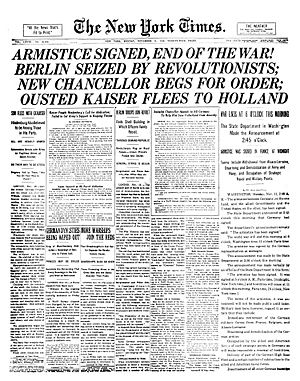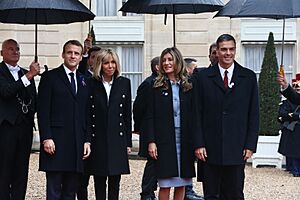Armistice Day facts for kids
Quick facts for kids Armistice Day |
|
|---|---|

Front page of The New York Times on Armistice Day, 11 November 1918
|
|
| Observed by | Australia, Belgium, Canada, France, New Zealand, Romania, Serbia, United Kingdom and many other countries |
| Significance | Commemoration of the signing of the Armistice between the Allied Powers and the Central Powers effectively ending all military operations and hostilities in all theatres and fronts of World War I at Compiègne, France |
| Date | 11 November |
| Next time | 11 November 2025 |
| Frequency | Annual |
| First time | World's first official observance at Buckingham Palace, London, on 11 November 1919 |
| Related to | Remembrance Sunday, Remembrance Day (Commonwealth), National Independence Day (Poland), National Unity and Armed Forces Day (Italy), Veterans Day (United States); |

Armistice Day is a special day celebrated every year on 11 November. It marks the end of fighting in World War I. An armistice is an agreement to stop fighting, like a truce. This important agreement was signed between the Allied Powers and Germany. It happened in Compiègne, France, in 1918.
The fighting officially stopped at 11:00 am on the "eleventh hour of the eleventh day of the eleventh month." This is why the date is so memorable. Even after the armistice, some fighting continued for a short time. A full peace agreement, called the Treaty of Versailles, was signed the next year.
Over time, the name of Armistice Day changed in many countries. In the Commonwealth of Nations, it is now often called Remembrance Day. In the United States, it is known as Veterans Day. France still celebrates it as a national holiday. Other countries have their own special days around this time. For example, Poland celebrates National Independence Day on 11 November.
Contents
How Armistice Day Began
The very first Armistice Day celebration took place in Buckingham Palace, London. This was on 11 November 1919. King George V hosted a special dinner the night before. On the day itself, people observed a two-minute silence. This silence was a way to honor those who died in the war. It also remembered the families left behind.
Other countries soon started similar ceremonies. For example, in South Africa, people would observe a moment of silence in darkness. Only a "Light of Remembrance" would shine. This honored "Fallen Comrades."
Changes Over Time
In Britain, during World War II, the two-minute silence was moved. It began to be observed on the Sunday closest to 11 November. This was done so it would not stop wartime production during the week. This day became known as Remembrance Sunday.
Initially, these celebrations focused on soldiers who died in World War I. They also celebrated the return to peace. After World War II, many countries changed the holiday's focus. They began to honor all veterans who served in their armed forces. Some countries also included all war dead, both soldiers and civilians. Most countries in the Commonwealth of Nations adopted the name Remembrance Day. The United States changed the name to Veterans Day in 1954.
Armistice Day Today
In the United Kingdom and other Commonwealth countries, Armistice Day is still observed. People hold a two-minute silence at 11:00 am. The main ceremony often happens on Remembrance Sunday. Both days are important but are not public holidays. A large service, the National Service of Remembrance, is held in London.
In the United States, Veterans Day honors all American veterans. This includes those who are still alive and those who have passed away. The official day to remember those killed in action is Memorial Day. Some people believe that 11 November should return to being a day focused on peace. They think it should be a day to reflect on how to achieve peace.
In France, the holiday is also known as Remembrance Day (Jour du Souvenir). In Belgium, it is still called Armistice Day (Jour de l'Armistice).
Special Commemorations
Serbia has observed 11 November as a public holiday since 2012. Serbian forces had a very high number of casualties in World War I. To remember their victims, people in Serbia wear a special flower. It is called Natalie's ramonda. This flower is a symbol of remembrance.
In Poland, 11 November is National Independence Day. It is a public holiday. This day celebrates Poland regaining its freedom in 1918. Poland had been divided by other empires for 123 years.
In Romania, Armistice Day is called Veterans' Day. It also marks the death of the first Romanian soldier in the Afghanistan war in 2003. Since 2015, the Romanian peony flower is used to honor Romanian soldiers.
In Kenya, ceremonies are held about two weeks after Armistice Day. This is because news of the armistice took longer to reach that part of the world. The German and British commanders there had to agree on their own armistice ceremony.
On 11 November 2018, the 100th anniversary of the Armistice was celebrated. Many leaders from around the world gathered in Paris, France. They met at the Arc de Triomphe to remember this important event.
See also
- Timeline of World War I


